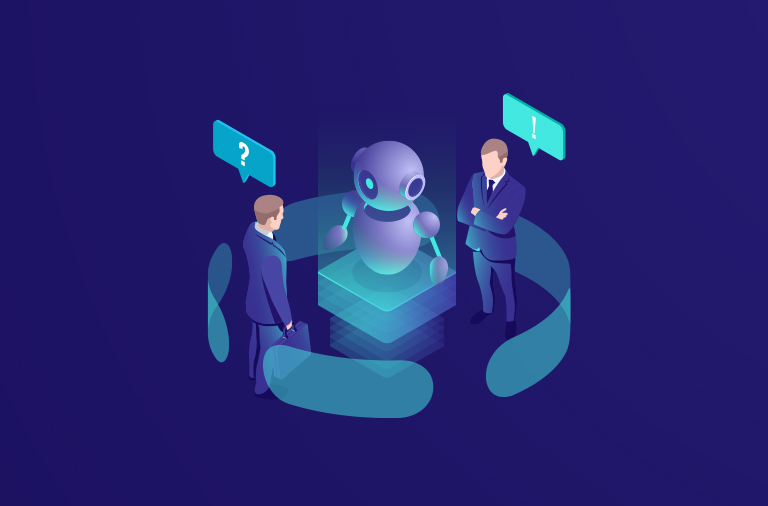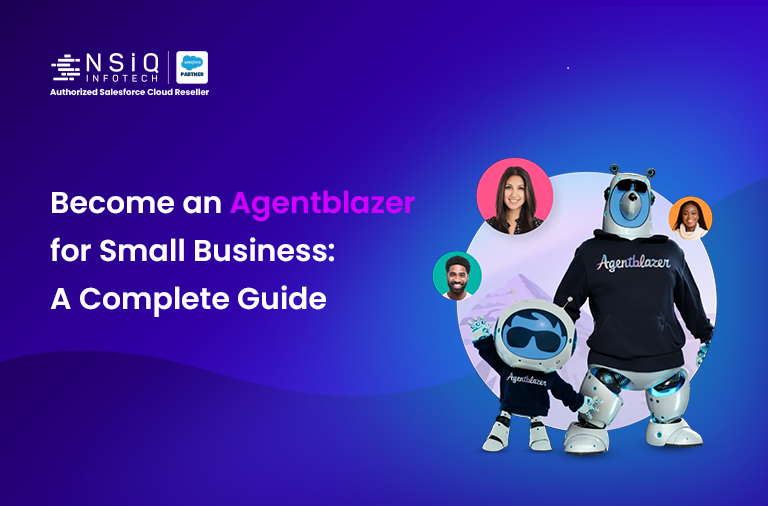Generative AI: The Secret Weapon in Salesforce

Introduction
In this blog, we will be discussing the trending topic of Salesforce which is Generative AI. On March 7, 2023, Salesforce, the global leader in CRM, launched Einstein GPT, the world’s first generative AI CRM technology. Generative AI is a type of artificial intelligence that can create new content. It means a sales cloud that not only remembers customer details but anticipates their needs and generates personalised content before they even ask. This is the magic of Salesforce generative AI, and it’s transforming the sales landscape as we know it.
Use of Salesforce Generative AI:
There are several approaches to developing generative AI models, but one that is gaining significant traction is using pre-trained, large-language models to create novels from text-based prompts. It helps people to create everything from resumes and business plans to lines of code and digital art. Generative AI holds immense potential across various fields, making it a valuable tool for many reasons.
Generative AI capabilities often involve the use of machine learning and natural language processing technologies. Here’s a general overview of how salesforce generative AI might work: Data Collection and Integration, Predictive Analytics, Machine Learning Algorithms, Natural Language Processing, Personalization, Customer Relationship Management and Content Generation.
How Does Generative AI Work?
For generative AI, models are trained to recognize patterns in data and then use these patterns to generate new, similar data. To put Generative AI in action, there are several models available in the market. Some of them are:
Generative Adversarial Networks:
Generative adversarial networks are a fascinating and powerful type of generative AI that takes a unique approach to content creation. A generative adversarial network is a class of machine learning frameworks and a prominent framework for approaching generative AI.
GAN(Generative Adversarial Networks) operate in a competitive, two-player setting, where two neural networks work against each other in a constant game of one-upmanship. Generative Adversarial Networks can be broken down into three parts.
- Generative: This network is the creative force, tasked with generating new content that resembles the provided dataset. Think of it as a skilled artist trying to mimic a style or paint something entirely new. This is the one who creates content based on the prompt received.
- Adversarial: This network acts as the critic, trying to distinguish between real data and the generator’s creations. This means that, in the context of GANs, the generative result is compared with the actual images in the data set. A mechanism known as a discriminator is used to apply a model that attempts to distinguish between real and fake images.
- Networks: The one who evaluates the authenticity of the content generated. It means the network system comprises two deep neural networks—the generator network and the discriminator network. Both networks train in an adversarial game, where one tries to generate new data and the other attempts to predict if the output is fake or real data.
Framework of GAN:
A Generative Adversarial Network is composed of two primary parts, which are the Generator and the Discriminator. They both function parallel to deliver the improved content simultaneously maintaining the quality. Let’s understand it with an example:
Generator Model:
A key element responsible for creating fresh, accurate data in a Generative Adversarial Network (GAN) is the generator model. The generator takes random noise as input and converts it into complex data samples, such text or images. It is commonly depicted as a deep neural network. The training data’s underlying distribution is captured by layers of learnable parameters in its design through training. The generator adjusts its output to produce samples that closely mimic real data as it is being trained by using backpropagation to fine-tune its parameters. The generator’s ability to generate high-quality, varied samples that can fool the discriminator is what makes it successful.
Adversarial Model:
An artificial neural network called a discriminator model is used in Generative Adversarial Networks (GANs) to differentiate between generated and actual input. By evaluating input samples and allocating probability of authenticity, the discriminator functions as a binary classifier. Over time, the discriminator learns to differentiate between genuine data from the dataset and artificial samples created by the generator. This allows it to progressively hone its parameters and increase its level of proficiency. Convolutional layers or pertinent structures for other modalities are usually used in its architecture when dealing with picture data. Maximising the discriminator’s capacity to accurately identify generated samples as fraudulent and real samples as authentic is the aim of the adversarial training procedure. The discriminator grows increasingly discriminating as a result of the generator and discriminator interaction, which helps the GAN produce extremely realistic-looking synthetic data overall.
What Does Generative AI Bring to the Business?
Generative AI can be used to create targeted recommendations, personalised product suggestions, and engaging social media content. Generative AI is changing how businesses connect with customers and work smarter. It makes emails and chats feel like real conversations, keeping customers engaged. It also helps businesses know what people like, so they can make things that people want and make more money. Generative AI offers a treasure trove of potential for businesses, unlocking a wave of opportunities to boost efficiency, enhance customer experiences, and drive innovation. Here are some key benefits it brings: Generative AI is changing how businesses connect with customers and work smarter. It makes emails and chats feel like real conversations, keeping customers engaged. It also helps businesses know what people like, so they can make things that people want and make more money. Generative AI offers a treasure trove of potential for businesses, unlocking a wave of opportunities to boost efficiency, enhance customer experiences, and drive innovation. Here are some key benefits it brings:
Content Creation and marketing, Customer Interaction and Support, Personalization, Data Augmentation and Synthesis, Creativity and Design, Fraud Detection and Security, Innovation and Research, Automation of Repetitive Tasks.
Scrutinise Salesforce GPT Innovations:
Salesforce experienced significant success with Einstein GPT, leading the company to introduce additional cloud-based GPT offerings to the market. This expansion enables users of cloud services to leverage the capabilities of generative AI.
The Definitive list of Einstein GPTs driving customer success in salesforce customer 360.
Salesforce Sales GPT:
Salesforce Sales GPT is a powerful new tool that leverages the capabilities of generative AI to revolutionise the sales process. By consolidating generative AI and data on a unified platform, sales teams revolutionise their approach, selling smarter, quicker, and more efficiently.
Characteristics of Sales GPT
Lead Generating and Qualification:
Lead generation is the process of getting people interested in your product or service in the first place while lead qualification is the process of determining whether those people are actually good potential customers waiting to convert. Generative AI enables Salesforce to analyse large datasets to discover and qualify leads based on pre-established standards.
Sales Interaction and Customization:
Create dynamic sales content tailored to individual customer data and preferences, including personalised reports, presentation and social media content. Access real time coaching and insights powered by AI, providing suggestions and recommendations based on your interaction and the ongoing stage of the sales cycle. Receive data-driven guidance on the most effective next steps to take with each lead or opportunity through next best action suggestions.
Call transcription: Transcription of Calls:
Consider you lead a sales team in a call centre. Instead of manually jotting down notes after a call, utilise AI to transcribe the conversation into text. The AI can also analyse the dialogue, identifying essential points and necessary actions. This not only saves time but also enables your team to swiftly comprehend the next steps required based on the call.
Salesforce Service GPT:
Service GPT is a powerful tool that uses cutting edge AI and real-time data from the Data Cloud to improve customer experiences. It helps support teams focus on building solid client relationships while automating tedious chores.
Characteristics of Service GPT
Service Responses:
Using up-to-date flight information, booking history, and pertinent CRM preferences, the system in a travel agency instantly responds to a customer’s inquiry regarding the availability of flights to a particular location.
Case Summaries:
When a tech support firm resolves a customer’s computer problem, the system automatically generates a summary that includes the problem description, the procedures taken to solve it, and maintenance advice.
Knowledge Articles:
Articles of Knowledge In a software company, the system generates and updates articles with detailed instructions based on the most often encountered difficulties as support agents assist users in troubleshooting software faults.
Agent Coaching and Predictive Insights:
Provision of services GPT does more than just provide answers; it also undertakes data analysis and foresees possible problems. It has the ability to recognize at-risk cases, forecast customer attrition, and even recommend the best communication tactics for particular clientele. This gives agents insightful knowledge and guidance so they can provide proactive, individualised support.
Tailored Client Experiences:
Every client should have a distinct and flawless experience. By customising communications and suggestions based on each customer’s preferences and previous experiences, Service GPT makes this easier. Consider using consumer data to tailor follow-up emails, recommend pertinent articles from the knowledge base, or even present targeted promotions.
Salesforce Marketing GPT:
With the help of Marketing GPT, marketing teams can produce personalised content and campaigns at scale by leveraging first-party data from Data Cloud and generative AI. It uses AI that is completely connected with Marketing Cloud to help businesses engage with customers in meaningful ways across all channels.
Characteristics of Marketing GPT
Journey Optimization:
In Salesforce Marketing GPT, journey optimization refers to figuring out how to best assist your consumers as they navigate the purchase process. Utilising artificial intelligence (AI), the platform can determine the best ways to keep users interested, such as displaying product recommendations or providing tailored messaging to improve user experience.
Segmentation:
Consider segmentation as dividing your audience into various categories according to specific attributes. If you own an online business, for example, you could utilise segmentation to target clients who are more interested in sports things than in fashion items.
AI-based Data Integration:
AI connections are used by Salesforce Marketing GPT to translate and easily integrate different kinds of data from several sources. For instance, the AI connectors can assist in integrating data from disparate software programs if you have it saved about your customers. This way, you can observe your customers’ preferences and activities in their entirety without requiring any human labour.
Trust and Safety in Generative AI:
Salesforce understands how crucial security and trust are to AI-driven products. Because the generative AI engine is based on moral AI principles, client data is treated with the highest secrecy and integrity. Salesforce also gives businesses the power to keep control over their data, allowing them to be transparent and provide an explanation for decisions made by AI. This fosters confidence and trust in AI-driven CRM systems.
Conclusion:
Generative AI from Salesforce, which is seamlessly connected with the AI Cloud, is a significant advancement in the field of customer relationship management. This ground-breaking invention allows businesses to reimagine consumer interactions, generate growth, and outperform competition by combining data, artificial intelligence, and cloud technology. Businesses may build stronger, more meaningful relationships with their consumers and encourage loyalty and long-term success in a more competitive market by utilising AI-driven personalization and automation. A new era of innovation and customer-centricity is heralded by organisations adopting Salesforce Generative AI, which will enable them to reinvent CRM strategies and transform customer engagement and experiences. According to Salesforce, AI-driven CRM will enable companies to provide unmatched customer experiences and maintain their position as leaders in the digital. If you want to make the maximum utilization of generative AI for your business, then contact NSIQ INFOTECH – the best salesforce development company in USA.
related blog




